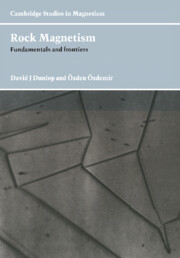Book contents
- Frontmatter
- Contents
- Preface
- Chapter 1 Magnetism in nature
- Chapter 2 Fundamentals of magnetism
- Chapter 3 Terrestrial magnetic minerals
- Chapter 4 Magnetostatic fields and energies
- Chapter 5 Elementary domain structures and hysteresis
- Chapter 6 Domain observations
- Chapter 7 Micromagnetic calculations
- Chapter 8 Single-domain thermoremanent magnetization
- Chapter 9 Multidomain thermoremanent magnetization
- Chapter 10 Viscous and thermoviscous magnetization
- Chapter 11 Isothermal magnetization and demagnetization
- Chapter 12 Pseudo-single-domain remanence
- Chapter 13 Crystallization remanent magnetization
- Chapter 14 Magnetism of igneous rocks and baked materials
- Chapter 15 Magnetism of sediments and sedimentary rocks
- Chapter 16 Magnetism of metamorphic rocks
- Chapter 17 Magnetism of extraterrestrial rocks
- References
- Index
Chapter 9 - Multidomain thermoremanent magnetization
Published online by Cambridge University Press: 06 July 2010
- Frontmatter
- Contents
- Preface
- Chapter 1 Magnetism in nature
- Chapter 2 Fundamentals of magnetism
- Chapter 3 Terrestrial magnetic minerals
- Chapter 4 Magnetostatic fields and energies
- Chapter 5 Elementary domain structures and hysteresis
- Chapter 6 Domain observations
- Chapter 7 Micromagnetic calculations
- Chapter 8 Single-domain thermoremanent magnetization
- Chapter 9 Multidomain thermoremanent magnetization
- Chapter 10 Viscous and thermoviscous magnetization
- Chapter 11 Isothermal magnetization and demagnetization
- Chapter 12 Pseudo-single-domain remanence
- Chapter 13 Crystallization remanent magnetization
- Chapter 14 Magnetism of igneous rocks and baked materials
- Chapter 15 Magnetism of sediments and sedimentary rocks
- Chapter 16 Magnetism of metamorphic rocks
- Chapter 17 Magnetism of extraterrestrial rocks
- References
- Index
Summary
Introduction
Multidomain (MD) grains have three likely sources of TRM:
(1) pinning of domain walls;
(2) domain nucleation or denucleation (transdomain TRM);
(3) nucleation failure (metastable SD grains).
Pinned domain walls have received the most attention and will be the subject of §9.2–9.7. Transdomain TRM was described from a theoretical point of view in §7.10; the experimental evidence and its interpretation will be dealt with in §9.8. Metastable single-domain TRM is the subject of §9.9.
Pinned domain walls can be thermally activated just as SD moments can. Wall displacements in response to a weak field applied at high temperatures, like reversals of SD grains, can be frozen in by cooling to room temperature, resulting in TRM. Analog theories of TRM due to pinned walls (Néel, 1955; Everitt, 1962a; Schmidt, 1973) have therefore been constructed along the lines of the Néel (1949) SD theory outlined in Chapter 8. In these theories, V becomes the volume of one Barkhausen jump of a wall or wall segment and HK becomes the critical field for such a Barkhausen jump.
We should recognize, however, certain fundamental differences between SD and MD TRM. No individual wall can be treated independently of its neighbours in an MD grain. The internal demagnetizing field Hd favours a set of wall displacements yielding minimum net moment for the grain. In order to achieve this minimum-internal-field condition, walls may undergo a series of jumps during heating or cooling, even if the field remains constant.
- Type
- Chapter
- Information
- Rock MagnetismFundamentals and Frontiers, pp. 234 - 261Publisher: Cambridge University PressPrint publication year: 1997



